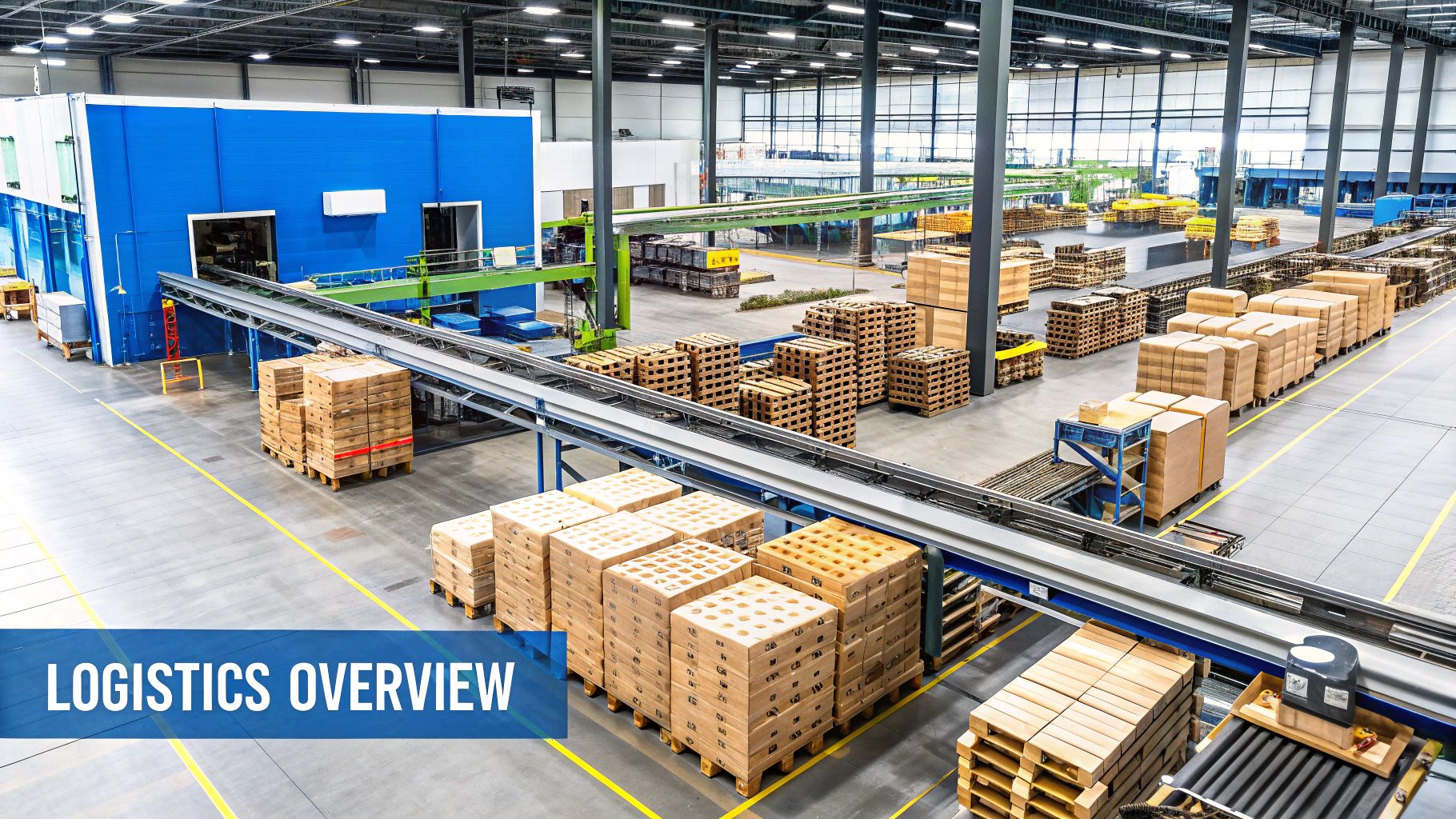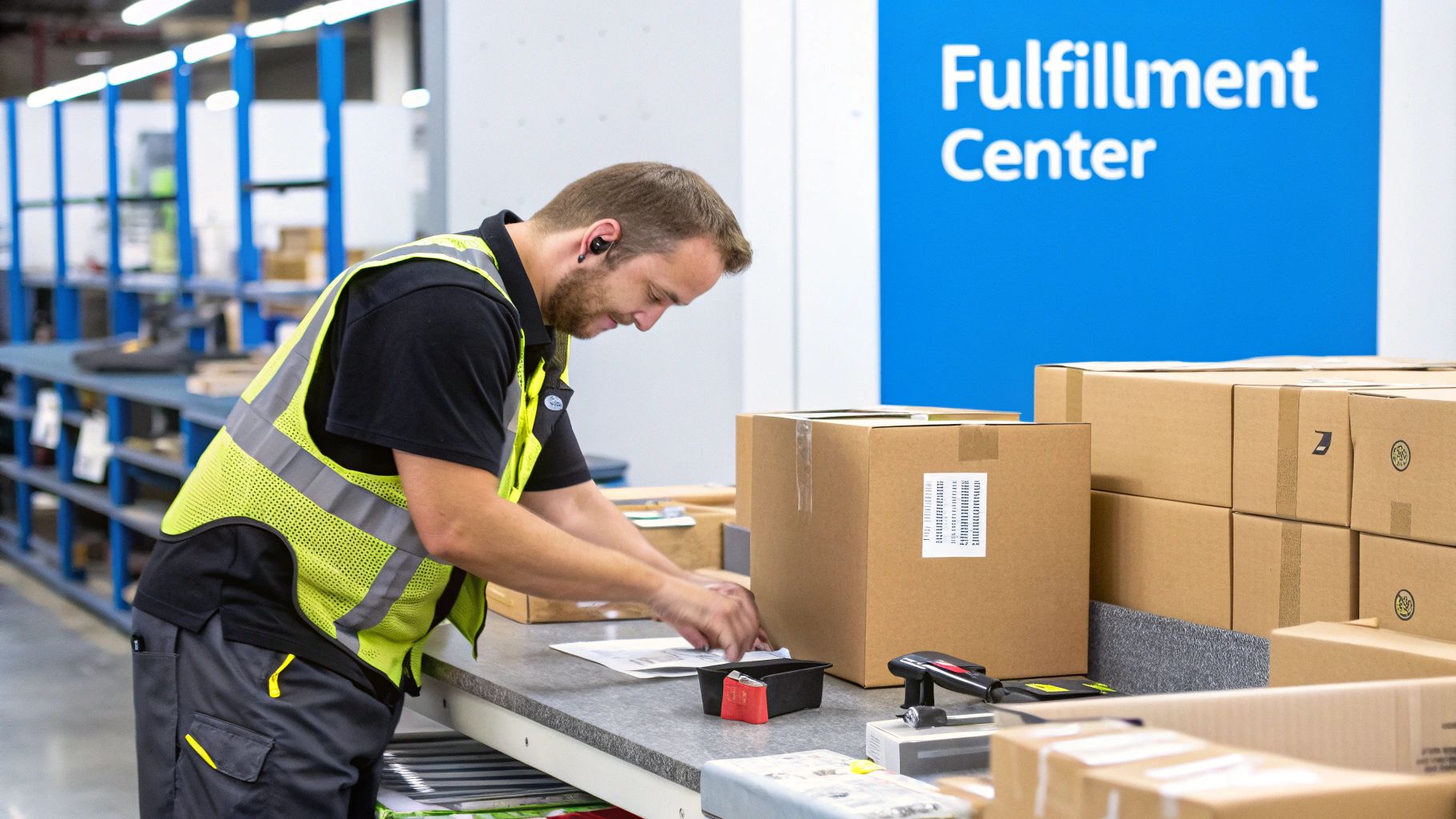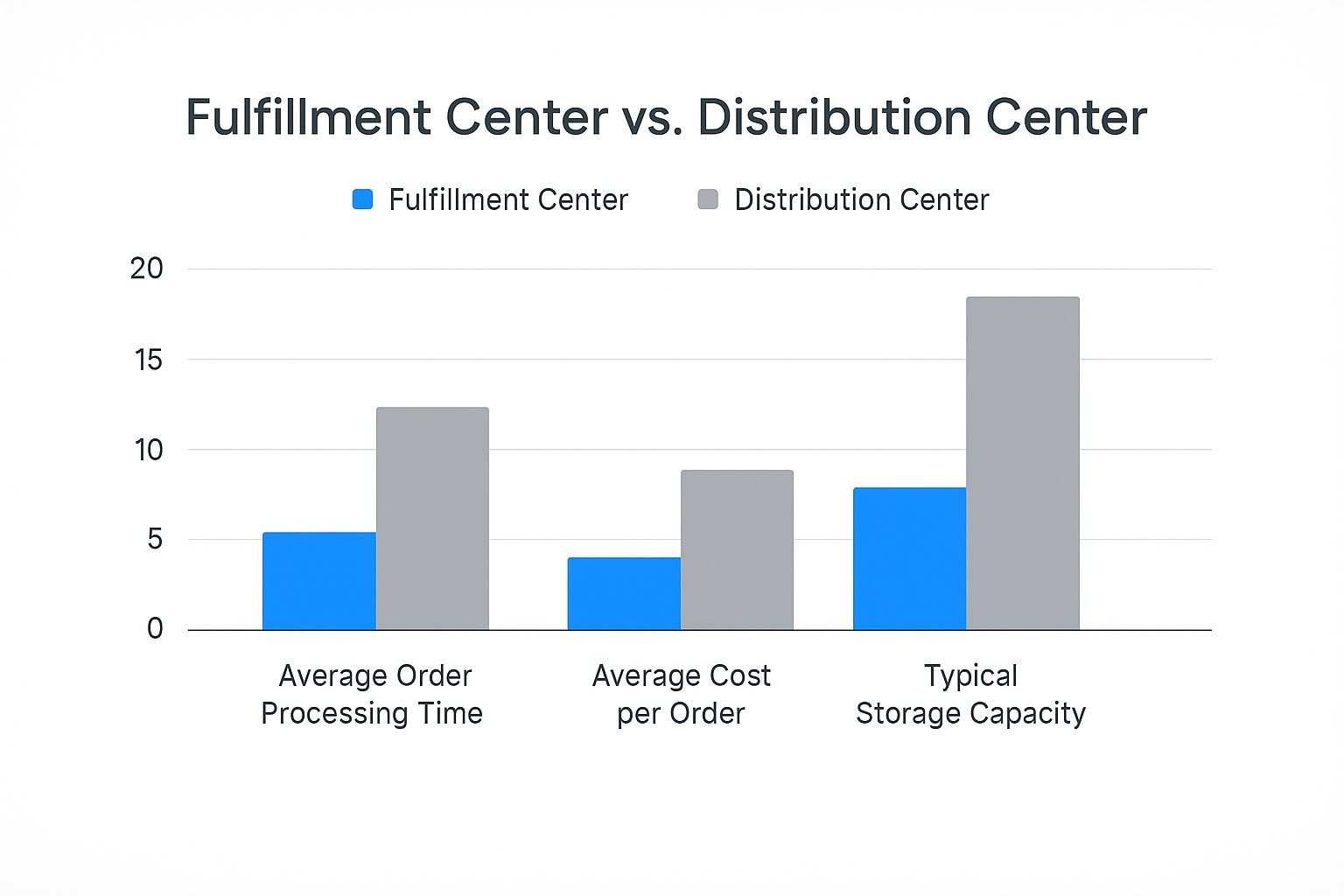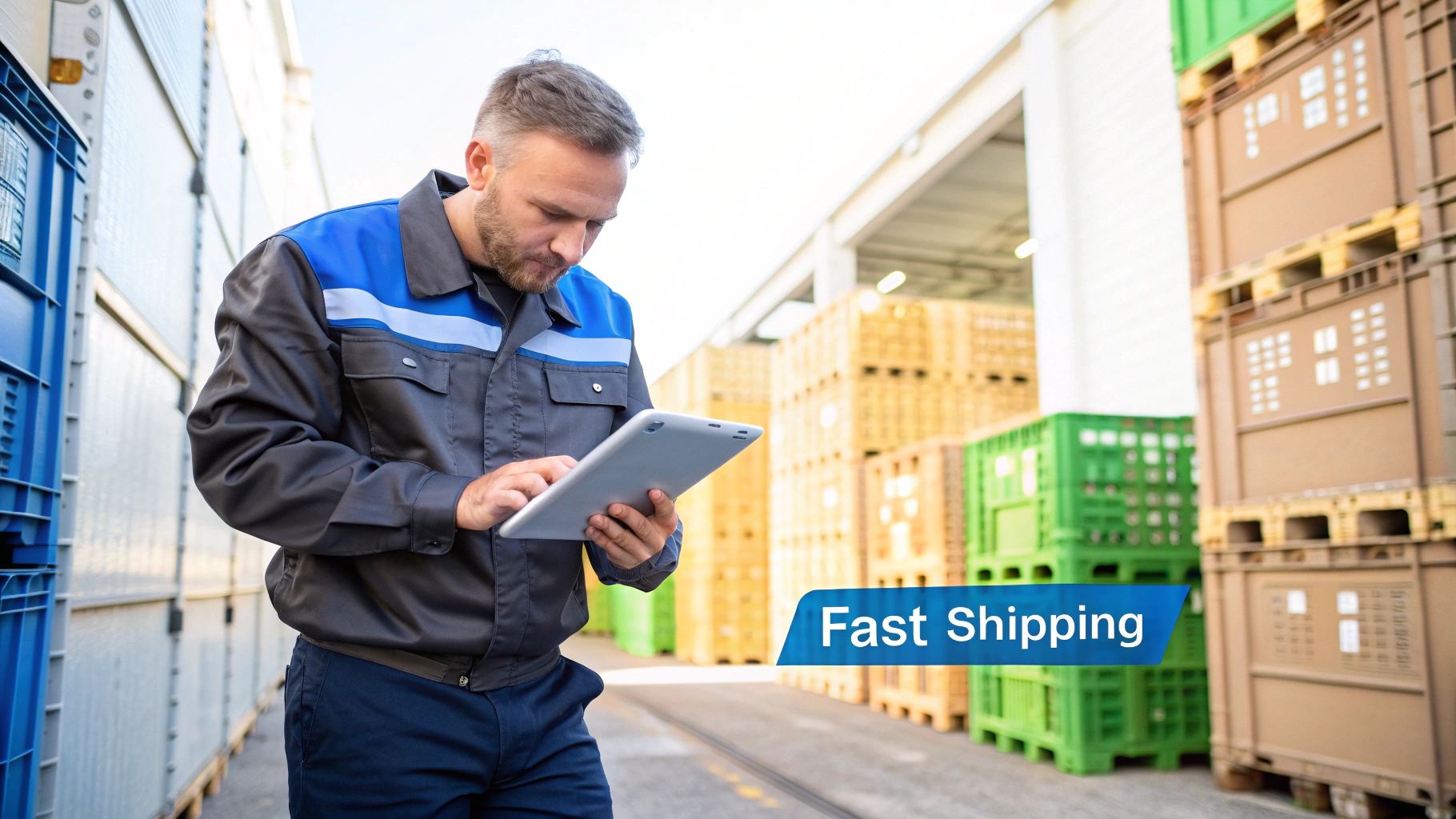The real difference between a fulfillment center vs distribution center boils down to a single question: who is the final customer?
Fulfillment centers are all about shipping small orders directly to individual customers (D2C). Distribution centers, on the other hand, move large quantities of product to other businesses, like retail stores (B2B). Your choice hinges entirely on who you're selling to and how fast you need to get your products into their hands.

Choosing between a fulfillment center and a distribution center is a defining moment for your supply chain. These facilities aren't just interchangeable warehouses; they are strategic assets engineered for fundamentally different jobs. This single decision will ripple through your entire operation, affecting shipping speeds, operational costs, customer happiness, and your very ability to grow.
A fulfillment center is built for speed and precision. Its entire operation is tuned to pick, pack, and ship a high volume of small, unique orders going to countless different doorsteps. Think of it as the final, direct link between your product and your customer.
In contrast, a distribution center is designed for bulk and efficiency. Its purpose is to act as a central hub, taking in massive shipments from manufacturers and methodically sending out large, palletized orders to a much smaller list of business destinations.
The most critical distinction lies in who receives the goods. Everything else flows from this.
This one difference dictates everything from the technology used inside the building to its physical layout. To get a handle on this, you first need a solid grasp of mastering your e-commerce supply chain.
The core question isn't "Which building is better?" It's "Which logistics model fits my business?" A fulfillment center is customer-centric. A distribution center is supply chain-centric.
To see the high-level differences at a glance, just look at what each facility is designed to do best.
This simple breakdown shows exactly why you can't just swap one for the other without creating massive operational headaches and blowing up your budget. They are two different tools for two very different jobs.
 The supply chain we know today wasn't built in a day. It was forged by massive shifts in how we all shop, and understanding that history is the key to settling the fulfillment center vs distribution center debate. Each facility was born to solve a specific problem for a specific era of retail.
The supply chain we know today wasn't built in a day. It was forged by massive shifts in how we all shop, and understanding that history is the key to settling the fulfillment center vs distribution center debate. Each facility was born to solve a specific problem for a specific era of retail.
For decades, distribution centers (DCs) were the undisputed kings of the logistics world. The flow of goods was simple and predictable: a manufacturer would ship pallets of a single product to a regional DC, and that DC would then send truckloads out to restock the shelves of brick-and-mortar stores.
This B2B model was engineered for one thing: efficiency at scale. The game was won by moving massive quantities of palletized goods as cheaply as possible. Success wasn't measured by how fast a single box got to someone's front door, but by the cost-per-pallet moved to a commercial business.
Then came e-commerce, and the entire system was turned on its head.
Suddenly, the "customer" wasn't a big-box store ordering 500 TVs. It was a person ordering one TV, a phone case, and a pair of socks—all to be delivered to their house. And they expected it to arrive in two days.
This created an urgent problem. The slow, methodical, bulk-oriented processes of a traditional DC were completely unprepared to handle thousands of tiny, unique orders flying out the door every hour. The industry needed a new type of facility, one built from the ground up for this new direct-to-consumer (D2C) reality.
And so, the modern fulfillment center (FC) was born. These buildings were specifically designed to do what distribution centers couldn't: process a high volume of individual orders with speed and accuracy for direct parcel shipment.
The core evolutionary driver was the shift in focus from B2B efficiency (cost-per-pallet) to D2C effectiveness (speed and accuracy per order). One model serves the supply chain; the other serves the end customer.
This split in purpose is crystal clear when you trace their development. The historical path of fulfillment and distribution centers is a direct reaction to retail dynamics, particularly the meteoric rise of online shopping. As you can learn from insights on SEKO Logistics, DCs were first set up as massive, centralized hubs for storing bulk inventory and pushing it out to retail stores. Their placement near ports or manufacturing centers was all about efficient mass distribution.
But as online sales exploded, customer demands for quick, direct-to-your-door delivery revealed the cracks in that model. This pressure led to the rise of fulfillment centers, which are designed for the very different tasks of speed and precision in handling single-item orders.
This deep operational divide is precisely why you can't just swap one for the other. A DC is a reservoir, holding huge amounts of stock to be released in predictable waves. An FC is a rapid-flow channel, designed to get products out the door almost as fast as they arrive. By understanding where each came from, you can make a much smarter decision about which one your business truly needs.
Walk into a distribution center and then a fulfillment center, and you'll immediately feel the difference. While both are massive buildings stocked with products, their internal rhythm, their daily pulse, is tuned for completely different customers and outcomes. One operates with a steady, predictable beat, while the other is a high-octane environment built for speed and complexity.
Think of a distribution center as a large reservoir. Its workflow is built around predictability and massive scale, handling large, uniform shipments with maximum efficiency to keep costs down.
A fulfillment center, on the other hand, is more like a fast-moving river. The entire operation is a dynamic, almost chaotic dance designed to get a high volume of small, unique orders out the door accurately and as quickly as humanly possible.
The fundamental split in their operations starts the moment inventory arrives. The nature of these inbound shipments dictates everything that follows.
This initial difference—pallet-in vs. case-in/each-in—is huge. It shapes the facility’s layout, the equipment needed, and the type of labor required right from the get-go. While both are technically managing inventory, their approaches couldn't be more distinct. For a deeper look at how these centers differ from standard warehouses, you can check out our guide on comparing fulfillment centers and warehouses.
Once products are inside, the way they are stored tells the whole story. One facility is built for holding, the other for moving.
A distribution center is all about maximizing space. You’ll see towering racks designed for high-density pallet storage. Since these pallets are moved infrequently, the goal is simple: cram as much product into the building as possible. The philosophy is long-term storage, acting as a strategic buffer in the supply chain.
Fulfillment centers are the complete opposite. Here, storage is optimized for fast and easy access to individual items. Instead of massive racks, you'll find dynamic shelving, flow racks, and even "chaotic storage" systems where products are placed in any open bin to make picking routes more efficient. Inventory turnover is the name of the game; products that sit still are wasting valuable space.
This infographic does a great job of showing how these operational philosophies affect key metrics.

As you can see, fulfillment centers are geared for speed, which means faster processing but often a higher cost per order. Distribution centers, in contrast, are built for massive capacity and cost-efficiency.
The biggest operational divide in the fulfillment center vs distribution center showdown happens when an order needs to go out. This is where their missions completely diverge.
A distribution center's outbound process mirrors its receiving. When a retail store requests a shipment, forklifts pull the required pallets from the racks. These pallets are then staged, consolidated, and loaded onto a freight truck. This is a pallet-out operation—low-touch and high-volume.
A fulfillment center's outbound process is a far more intricate, labor-intensive ballet. Here’s how it usually works for a single customer order:
To make the operational differences crystal clear, let's break down the typical workflow for each.
This table highlights the core activities and how they differ based on the facility's primary goal—moving bulk goods versus shipping individual customer orders.
As you can see, every step is tailored to a completely different end-user and a different definition of success.
A distribution center moves pallets. A fulfillment center processes orders.
This is the simplest way to think about it. This core distinction is precisely why an eCommerce brand’s success is so closely tied to the specialized, high-touch workflow of a modern fulfillment center.

When you dig into the fulfillment center vs distribution center debate, nothing tells the story better than how each facility treats the inventory on its shelves. It’s not just about storing products; it’s about the entire financial and operational philosophy that drives the business. This is where you see their core purpose in action.
A distribution center is essentially a large, stable reservoir of goods. It’s built for high-density, long-term storage, usually dealing with palletized products destined for other businesses. Inventory here is a stable asset, a big buffer that's waiting to restock retail stores or other B2B channels. The name of the game is maximizing space and minimizing the cost of holding bulk inventory over time.
Fulfillment centers are the polar opposite. They are engineered for chaos—or at least, for dynamic, short-term storage where rapid inventory turnover is king. Products aren't meant to get comfortable. The entire system is fine-tuned to get items in the door and back out to a direct-to-consumer order as fast as humanly possible.
In a distribution center, inventory is an asset awaiting a B2B order. In a fulfillment center, it's a liability until it ships to the end customer.
This isn't just a turn of phrase; it's a critical distinction. It shapes everything from storage costs and operational priorities to the financial viability of the businesses that rely on these facilities.
The financial models of these two facilities are a direct reflection of their inventory philosophy. Distribution centers are all about cost-effective bulk warehousing. They offer lower per-pallet storage rates because they expect goods to stick around for a while. Their revenue is tied to efficient, large-scale storage and movement.
Fulfillment centers run on a completely different economic engine. They actively discourage long-term storage, often slapping on higher fees the longer an item sits on the shelf. This isn't a bug; it's a feature. They need to keep stock moving to free up valuable, quick-access space for products that sell. Profitability comes from processing a high volume of orders, not from holding stagnant inventory.
This focus on speed means fulfillment centers are designed for rapid inventory cycling, often targeting a complete turnover in 30 days or less. Letting inventory sit longer than that usually triggers higher storage fees, as it ties up space that could be generating revenue from faster-moving products.
If there's one metric that perfectly captures the difference, it's inventory velocity—the speed at which goods move through the facility.
This stark contrast in velocity demands completely different management strategies. While effective https://www.simplfulfillment.com/blog/inventory-management is crucial for both, the approach and tools used can vary significantly. For any business trying to master their stock levels, digging into various inventory forecasting methods can provide a serious competitive advantage in either setting.
Ultimately, your product's sales cycle dictates which facility is the right fit. If you're selling fast-moving consumer goods directly online, a fulfillment center's model is built just for you. But if you're supplying large, infrequent orders to a handful of business clients, the structure of a distribution center is a much better operational and financial match.
The choice between a fulfillment center vs. distribution center goes way beyond simple operations. It's a fundamental financial decision that directly shapes your customer's experience, from the shipping fees they see at checkout to how quickly their order arrives. To get this right, you have to look past the definitions and dig into the distinct economic models each facility runs on.
A distribution center’s world revolves around a single metric: cost-per-pallet. Its entire design—from warehouse layout to staffing—is built to store and move large, uniform units of product as cheaply as possible. Success here is all about bulk freight efficiency, making it the perfect fit for B2B supply chains where large, predictable orders are the name of the game.
Fulfillment centers, on the other hand, live and die by a much more detailed number: the cost-per-order. This isn't one simple fee; it’s a bundle of tiny expenses. Think about the labor for a person to pick individual items, the cost of boxes and packing fillers, and the final bill for shipping a single parcel to someone's front door.
For most e-commerce brands, partnering with a fulfillment center or a third-party logistics (3PL) provider is where the magic happens, especially with shipping costs. These facilities ship thousands of packages every day, giving them access to massive volume discounts from carriers like FedEx and USPS—rates a smaller business could never hope to get on its own.
But this huge advantage comes with a critical trade-off. The entire model is built for speed, not long-term storage. While fulfillment centers do store your inventory, their systems are optimized for products that cycle out within about 30 days. Let stock sit for much longer, and you'll likely face steep storage penalties. It's a system designed to prioritize getting products to customers quickly over pure warehousing efficiency. For more on this, check out what logistics experts at NextSmartShip have to say.
This creates a very clear financial decision: you get to lower your per-package shipping costs, but you have to stay on top of your inventory turnover to avoid those painful storage fees.
Every logistical choice you make eventually lands—quite literally—on your customer's doorstep. The cost structure you operate under directly influences what they pay, how fast they get their order, and their overall impression of your brand. For any growing business, understanding why you should consider a 3PL for your ecommerce fulfillment is crucial for managing this customer-facing impact.
Let's break down how each model hits the end user.
Impact on Key Customer Metrics
Choosing your logistics partner isn't just an operational task; it's a core component of your customer experience strategy. Your facility's cost model dictates the promises you can make—and keep—to your buyers.
Ultimately, the financial analysis is pretty straightforward. If your brand's success depends on delighting individual customers with fast, accurate, and affordable shipping, the cost-per-order model of a fulfillment center is built for you. If you serve other businesses with large, infrequent shipments, the cost-per-pallet efficiency of a distribution center is the more logical and financially sound path.
Making the final call in the fulfillment center vs distribution center showdown isn't just about picking a warehouse. It’s a strategic choice that needs a clear-eyed look at your business—not just where it is today, but where you plan to take it. This decision will directly shape your costs, your customers' happiness, and your ability to grow. To get it right, you have to analyze your company's unique operational DNA.
The best place to start is with your order profile and customer base. Are you shipping a high volume of small, one-off orders straight to shoppers all over the country? Or are you moving a lower volume of big, palletized shipments to just a handful of business addresses? That single distinction is the most critical starting point.
Answering these questions honestly will light up the right path for your brand. Your logistics needs are a direct reflection of your sales model, your products, and your growth plans.
Let's put these questions into action with a few common business models to see how the right choice becomes clear.
Choosing the right partner isn't just about finding a warehouse; it's about finding a logistics engine that aligns perfectly with your business model and customer promises.
Scenario 1: The E-commerce StartupA new D2C brand is selling apparel on Shopify. They need a partner who can roll with fluctuating order volumes, ship quickly to individual customers, and handle returns without a fuss.
Recommendation: A fulfillment center is the only real option here. Its entire model—the D2C focus, pre-negotiated shipping rates, and value-added services—is tailor-made for this business.
Scenario 2: The Established B2B WholesalerA company supplies large quantities of industrial parts to a network of 50 commercial clients. They ship full pallets out on a predictable bi-weekly schedule.
Recommendation: A distribution center is the perfect fit. Its cost structure is built around bulk storage and efficient freight transport, which is a hand-in-glove match for a B2B workflow.
Scenario 3: The Omnichannel RetailerA major brand sells products on its website and in over 100 brick-and-mortar stores. They have to ship small online orders to customers and restock their retail locations with large bulk shipments.
Recommendation: A hybrid model is essential. This business needs both a fulfillment center to manage its e-commerce side and a network of distribution centers to run its B2B retail supply chain.
Making this decision is a major step. For a complete checklist and more in-depth advice, our detailed guide on evaluating fulfillment partners for your ecommerce business offers an essential framework. By carefully matching your specific needs against the distinct roles of each facility, you can confidently pick the logistics partner that will not only support your current operations but also power your future growth.
Even after breaking down the differences between a fulfillment center vs distribution center, some practical questions always pop up. Let's tackle some of the most common ones we hear from e-commerce brands trying to figure out their next move.
Absolutely. In fact, many larger businesses rely on a hybrid model to run their operations smoothly. An omnichannel retailer is a perfect example of this.
They use distribution centers to move bulk inventory to their physical stores—a classic B2B model. At the same time, they depend on fulfillment centers to handle the fast-paced world of direct-to-consumer online orders. This dual strategy lets them fine-tune each side of their supply chain for what it does best: B2B efficiency on one end, and D2C speed and customer experience on the other.
A Third-Party Logistics (3PL) provider is essentially a company you hire to manage your logistics. A 3PL might run fulfillment centers, distribution centers, or even a mix of both.
For a growing e-commerce brand, teaming up with a 3PL that specializes in fulfillment is often the smartest path forward. It gives you immediate access to advanced warehouse tech, deeply discounted shipping rates, and a team of experts without the massive upfront investment of building it all yourself.
Think of a 3PL as your logistics partner on demand. They bring the infrastructure (the fulfillment or distribution center) and the services, freeing you up to focus on what you do best—developing great products and marketing your brand.
In a way, yes. A fulfillment center is a type of warehouse, but it's a highly evolved and specialized one built for the demands of e-commerce. A traditional warehouse is all about storage. A fulfillment center, on the other hand, is an active, humming hub of technology and processes designed specifically for picking, packing, and shipping individual orders directly to customers' doorsteps.
Just look at the rise of automation and robotics in facilities run by companies like Amazon, which can slash order processing times by up to 25%. It shows just how far these centers have come from simple storage sheds.
You're ready for a fulfillment center when shipping orders yourself starts holding your business back. It's that tipping point every founder reaches.
If you're spending more time taping up boxes than you are building your brand, it's time. If you can't keep up with the flood of orders and still get them out the door quickly, it's time. Making the switch to a fulfillment partner is what allows you to scale up without sacrificing the speed and accuracy your customers have come to expect.
Ready to stop packing boxes and start scaling your brand? Simpl Fulfillment offers a dedicated partnership with lightning-fast, same-day fulfillment, transparent pricing, and seamless integrations. Let us handle the logistics so you can focus on growth. Get your free quote today at Simpl Fulfillment.